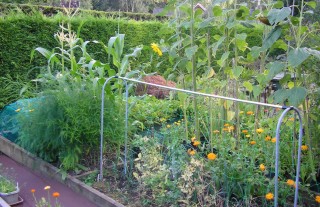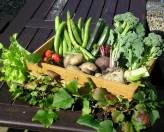Skip to content | Skip to navigation
Calendar • Specific Fruit & Veg • Dictionary • Useful Sites
Growing your own Vegetables and Fruit
Enjoy growing and eating fresh veg and fruit when you want it.
Here, help is at hand month by month so you can see what you should be doing on your plot when growing your own vegetables and your own fruit. The weather and where you live make a huge difference to what grows, or not, but doing anything is better than nothing. Use the links above if you want specific information on a fruit or veg, or to see what you should have done last month.
 |
Summer 2019 The plot in the summer is inspiring and full of hope; everything is growing, and you are harvesting as well, so it all seems worthwhile. Every evening I clip some chives, lettuce leaves, rocket, and maybe pull a radish to have an instant zero-food mile salad, and it’s lovely. |
Later on there’ll be some tomatoes, and hopefully a cucumber to join it, and maybe a baby carrot. The asparagus treat comes to an end this month, but the beautiful ferns that develop promise more for next year. And hopefully I’ll be enjoying a pea and broad bean risotto, if the pigeons have left my patch alone this year. Tender Loving Care is needed for plants in June, and they will grow healthy and strong. June 2010 was the driest ever and 2012 was the wettest ever, but hopefully this year will be better. You can still have plants under cloches and bottles, and covers in June, but remove them during the day. In the bright sun the plants could actually wilt and leaves get burned. Remember to pop them on again overnight if the plants they are protecting are still new to the outside world. Cloches also protect plants that may get flattened by heavy rain. Plants may look weak and pathetic if they have had a bit of a shock being put outside, but don’t worry, they will pick up. Tomato plants should be well attached to supports, and pick out the shoots that appear between the branches, so that you have one main stem going up, with leaves branching off. If you don’t you’ll have lots of main stems and it’s impossible to stake them, and there will not be enough light getting to the fruit. Next month you can trim off some of the leaves to let light through to the fruit. Water can be a big issue in June. Ideally of course it will rain at night, and be sunny during the day, and your well-prepared soil will hold the moisture. But you can help by putting small amounts of grass mowings around plants, and over potatoes once it has rained. If you are using a watering can filled from water butts, give the plants a good soaking at night, every few days. If it is dry some plants will bolt. So, either water to prevent this, or be prepared to lose some, which should be lifted once they have bolted (producing a flower). The exception is any plant whose flower you like to keep, like onions, or rocket – they make the plot look pretty. Check fruit blossom for any maggots, or moths and remove by hand if you can. If the plants are new, make sure they get plenty of water if there’s been little rain. Weeds go mad in June, either from the rain, or your watering! So keep hoeing them off. Perennial weeds need to be dug out if possible or at least cut off under the soil if you do not want to disturb nearby crops. They’ll come back, but if you don’t pull them up at least you’ll keep the soil intact. You can put a square of permealay over a weed, and put a rock on top, which will weaken it. Keep staking plants like beans, peas and tomatoes as they grow so that a sudden strong wind does not snap them off. Any plant will welcome being shielded from wind in June. You can put up a makeshift wind shelter by tying fleece between canes, or a sheet of Perspex trapped between canes. It need only be temporary, but it must be secure. Earth up, and firm down brassica plants so they stand rock solid. If they rock about then they tend not to form a heart (cabbage) or the broccoli head, or the cauliflower floret. A full grown brassica plant can be huge, with a thick stalk, so they need a firm solid ground to support them. Potatoes should be earthed up, or at least covered in a thick mulch to prevent any light getting to the tubers. Check rows of seeds like carrots, parsnips, beetroot, spinach, beet, radish, salad onion, rocket that you have sown, and thin them out so that the seedlings can get a bit of air and water. Some of the seedlings you can transplant, others just wash and use in a salad. If you’ve got sporadic patches of seedlings, sow some more seed in the spaces; you’ll have a successional crop, just not in an orderly line! Watch out when thinning carrots and do it at night. The carrot root fly is attracted by the smell, so doing it at night may help, or try and confuse it by rubbing chives nearby as that smell they do not like! If you can, use a mesh cover over your carrots and this will keep the fly away. Interestingly there is no insecticide licensed for domestic control of carrot root fly, so everyone has to be organic when it comes to carrots. To get a good fruit crop you do have to thin. It’s hard, but worth it if you want to go for quality. Fruits that grow next to each other rub, get diseased, go brown and are useless. So for pears, apples, gooseberries, it is worth picking off weaker fruits, leaving two per ‘bunch’ to get all the nutrients, sun, air needed to produce the perfect fruit. In a dry summer the plant will naturally drop a lot of fruit anyway. Cherry and plum trees can be pruned, but be careful of the fruit. Tomatoes like lots of water and an organic feed s they set their flowers (make your own from comfrey or nettles, or buy from HDRA). Bedding plants can safely go out now, but keep checking for slugs until the plants get established. Dead heading of flowers will keep the plants flowering for longer. Container veg tends to be thought of as for those without a garden, or plot. But anyone can use containers, and they have many uses in the veg plot: I put flowers in troughs and move them near veg that need beneficial insects; Hungry plants like courgettes and pumpkins can go in a container, and it makes watering easier; You can get a good crop of potatoes from just a couple of tubers planted in a big pot (yep, sprouted, unused supermarket ones are fine for a container); If slugs get everything in your plot, put some come-again lettuce in a pot and snip as required; Herbs like Basil and Parsley do better in a large pot than open ground in wet areas; Carrots can be grown in a pot if they fail in your open ground. Strawberries and raspberries look after themselves, but do like plenty of water when the fruit is swelling. You are not supposed to harvest from new plants, you are supposed to pick off the flowers so no fruit is formed, to make a stronger plant for future years! Fruit that lies on the ground (strawberry, cucumber, courgette) can get nibbled by slugs, so put some straw or material under the fruit to keep it off the soil. You need to make sure you are sowing some brassicas for next winter, and spring. They do hog the ground for a long time, but you will welcome their presence next year when everything else is empty. Ideally you’ll have a ‘holding bed for the seedlings, so that you can then move to their permanent home later in the summer. If not, keep the seedlings in pots. Pests! It’s hard to know whether to be bothered by pests, or not. On the whole in a ‘healthy’ garden, you will have pests and predators doing their thing. Pests will appear before predators, so just rubbing them off will keep them at bay. Similarly rub off greenfly and black fly, and the ladybirds and hoverflies will move in soon. Mind you, blackfly is so horrible to look at it’s best to snip off really infected areas. With broad beans snip off the growing tip if it’s covered in blackfly and remove from your garden. Young brassica plants get little holes in the leaves made by flea beetle, but it’ll pass. I pick off slugs and snails when I see them, there will be plenty more for frogs and thrushes that I can’t see. Check for infected potatoes, and other pests. You’ll know an infected potato as the foliage will be withered and yellow compared to the others, so dig it out and remove it from your garden.. If you see caterpillars anywhere (brassica, gooseberry) pick them off, and give them to the birds. And it’s the end of rhubarb harvesting once June is over. Just mulch heavily and leave them alone. Plant this month: (and then water and weed!) Also, take cuttings of herbs and pot them up to replace lost plants, or give to friends!
|
|


